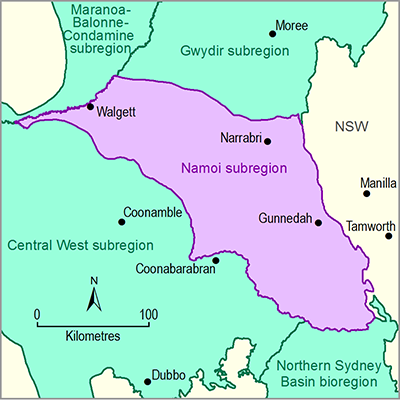- Home
- Assessments
- Bioregional Assessment Program
- Namoi subregion
- 2.7 Receptor impact modelling for the Namoi subregion
- 2.7.5 Pilliga riverine landscape classes
- 2.7.5.3 Choice of hydrological response variables and receptor impact variables
In bioregional assessments (BAs), the potential ecological impacts of coal resource development are assessed in two future years – 2042 and 2102. These are labelled as the short- and long-assessment years, respectively. Potential ecological changes are quantified in BAs by predicting the state of a select number of receptor impact variables in the short- and long-assessment years. These predictions are made conditional on the values of certain groundwater and surface water statistics that summarise the outputs of numerical model predictions in that landscape class in an interval of time that precedes the assessment year. In all cases these predictions also allow for the possibility that changes in the future may depend on the state of the receptor impact variable in the reference year 2012, and consequently this is also quantified by conditioning on the predicted hydrological conditions in a reference interval that precedes 2012 (companion submethodology M08 (as listed in Table 1) for receptor impact modelling (Hosack et al., 2018)).
For surface water and groundwater variables in the Namoi subregion, the reference assessment interval is defined as the 30 years preceding and including 2012 (i.e. 1983 to 2012). For surface water variables in the Namoi subregion, the short-assessment interval is defined as the 30 years preceding the short-assessment year (i.e. 2013 to 2042), and the long-assessment interval is defined as the 30 years that precede the long-assessment year (i.e. 2073 to 2102). For groundwater, maximum drawdown (metres) and time to maximum drawdown are considered across the full 90-year window: 2013 to 2102.
In BAs, choices about receptor impact variables must balance the project’s time and resource constraints with the objectives of the assessment and the expectations of the community (companion submethodology M10 (as listed in Table 1) for analysing impacts and risks (Henderson et al., 2018)). This choice is guided by selection criteria that acknowledge the potential for complex direct and indirect effects within perturbed ecosystems, and the need to keep the expert elicitation of receptor impact models tractable and achievable (companion submethodology M08 (as listed in Table 1) for receptor impact modelling (Hosack et al., 2018)).
For all riverine landscape classes in the Pilliga, the qualitative modelling workshop identified three variables – two flow regimes and groundwater – as the hydrological factors that were thought to (i) be instrumental in maintaining and shaping the ecosystem and, (ii) have the potential to change due to coal resource development. All of the ecological components and processes represented in the qualitative model are potential receptor impact variables and all of these are predicted to vary as the hydrological factors vary either individually or in combination (Table 36).
Following advice received from participants during (and after) the qualitative modelling workshop, and guided by the availability of experts for the receptor impact modelling workshop, the scope of the BA numerical modelling and the receptor impact variable selection criteria, the receptor impact models focused on the following relationships:
- the response of the riparian trees to changes in zero-flow days (ZQD) and groundwater (dmaxRef)
- the response of families of aquatic macroinvertebrates in instream pool habitats to changes in zero-flow regime (ZQD, ZME) and groundwater drawdown (dmaxRef).
The hydrological factors identified by the participants in the qualitative modelling workshops have been interpreted as a set of hydrological response variables. The hydrological response variables are summary statistics that (i) reflect these hydrological factors, and (ii) can be extracted from the BA numerical surface water and groundwater models during the reference, short- and long-assessment intervals defined previously. The hydrological factors and associated hydrological response variables for the Pilliga riverine landscape classes are summarised in Table 37. The precise definition of each receptor impact variable, typically a species or group of species represented by a qualitative model node, was determined during the receptor impact modelling workshop.
Using this interpretation of the hydrological response variables, and the receptor impact variable definitions derived during the receptor impact modelling workshop, the relationships identified in the qualitative modelling workshop were formalised into two receptor impact models (Table 38).
Table 37 Summary of the hydrological response variables used in the receptor impact models for the Pilliga riverine (upland and lowland) landscape classes, together with the signed digraph variables
Table 38 Summary of the receptor impact models developed for the Pilliga riverine (upland and lowland) landscape classes

Product Finalisation date
- 2.7.1 Methods
- 2.7.2 Prioritising landscape classes for receptor impact modelling
- 2.7.3 'Floodplain or lowland riverine' landscape group
- 2.7.4 'Non-floodplain or upland riverine' landscape group
- 2.7.5 Pilliga riverine landscape classes
- 2.7.6 'Rainforest' landscape group
- 2.7.7 'Springs' landscape group
- 2.7.8 Limitations and gaps
- Citation
- Acknowledgements
- Contributors to the Technical Programme
- About this technical product
